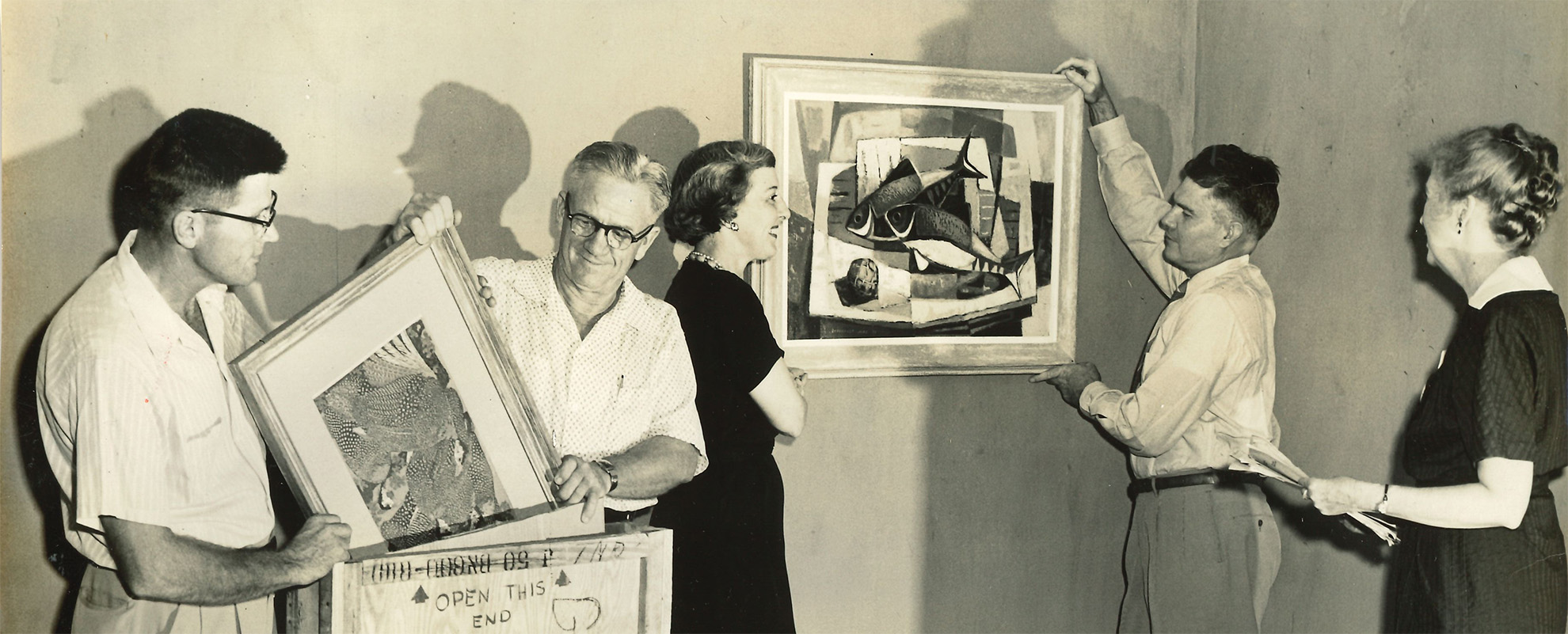While digging through the archives at the Art Museum of Southeast Texas (AMSET), Curator of Exhibitions Caitlin Clay discovered a picture of herself from when she was just two years old. At the time, her parents had taken her to one of the museum’s popular Free Family Arts Days, a program she now facilitates herself. “I’m from Beaumont. This is like my hometown museum,” Clay says, explaining that she’s just one of many who have grown up with AMSET and gone on to support it throughout its 75 years.
The first of the 75th anniversary shows, The Legacy of Collecting: Beaumont Art Museum starts with AMSET’s formation in 1950 as the Beaumont Art Museum. It chronicles the museum’s development across those early decades intertwined with the Beaumont Art League through 1987 when it moved to its current space and became AMSET. The exhibition will run Oct. 4, 2025-Jan. 4, 2026.
Clay says the anniversary shows will include artwork alongside educational panels filled with information she has gathered from the museum’s various scrapbooks and historical records. They will also discuss some of the prominent artists who have exhibited at AMSET, like John Alexander, Keith Carter and Paul Manes.
“I am constantly impressed by how thorough they were in the beginning years,” Clay says of exploring the museum’s records. She describes how AMSET began after the local Women’s Club and the Beaumont Art League both formed in the mid-40s with similar artistic goals. They decided they wanted to create a museum for exhibiting works, along with an accompanying school to offer teaching opportunities and workshops that would serve the dual purpose of financially sustaining the museum.
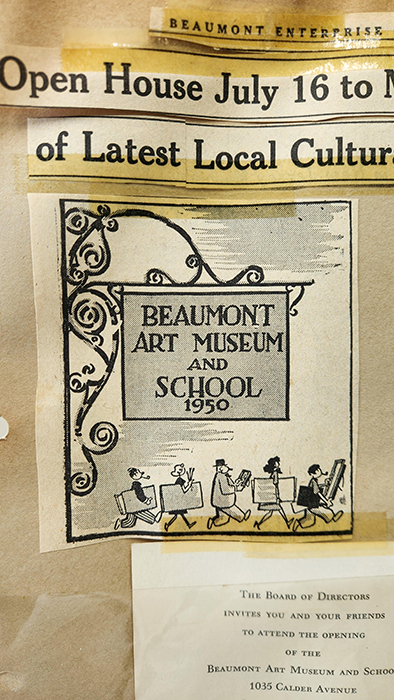
1 ⁄12
Dennis McCarthy, Beaumont Art Museum and School cartoon illustration, circa 1950. Image courtesy of the Art Museum of Southeast Texas
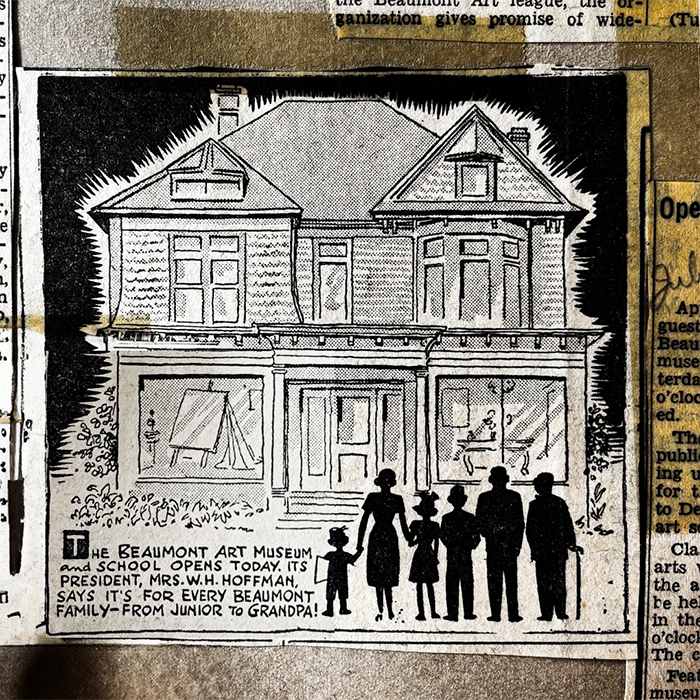
2 ⁄12
Dennis McCarthy, Beaumont Art Museum and School cartoon illustration, circa 1950. Image courtesy of the Art Museum of Southeast Texas
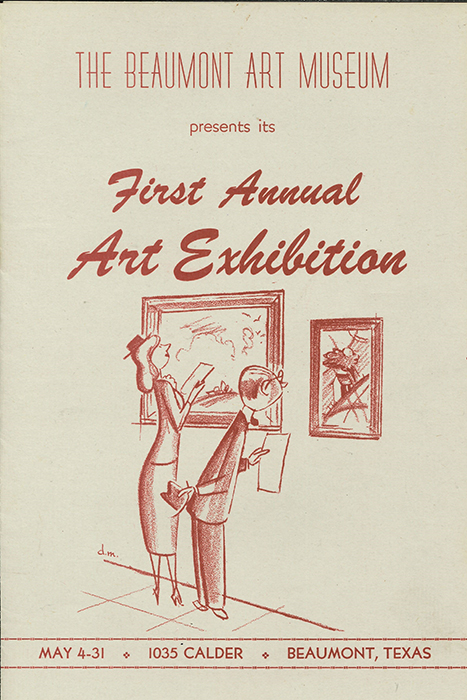
3 ⁄12
Beaumont Art Museum First Annual Art Exhibition pamphlet, art by Dennis McCarthy, circa 1952. Image courtesy of the Art Museum of Southeast Texas

4 ⁄12
Newspaper clipping. Lorene David, far right, chairman, and Mrs. Joe B. Price, members of the exhibition committee, advise with artist Herring Coe on how best to place a painting for exhibition purposes. Left as named are other members of the hanging committee, O.J. Hayes and S. W. Scurlock demonstrating the careful handling of paintings during the crating for shipment process. Circa 1954. Artworks in image are (left) Janet Turner, Guinea Fowl, 1952, relief print, PC 1952.02 and (right) DeForrest Judd, Blue Fish, 1953, oil on Masonite, PC 2009.08. Image courtesy of the Art Museum of Southeast Texas.
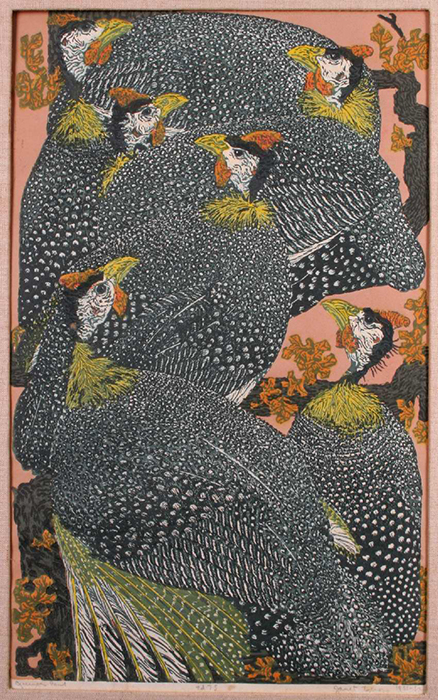
5 ⁄12
Janet Turner, Guinea-Fowl, 1952. Relief print PC-1952.02. Gift from Mrs. W.H. Hoffman.
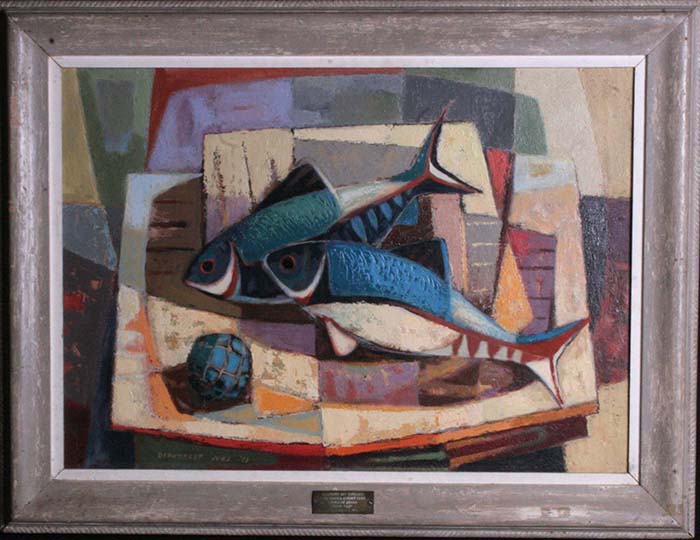
6 ⁄12
DeForrest Judd, Blue Fish, 1953, oil on masonite, PC 2009.08, BAM 2nd Annual Exhibition Purchase Award.
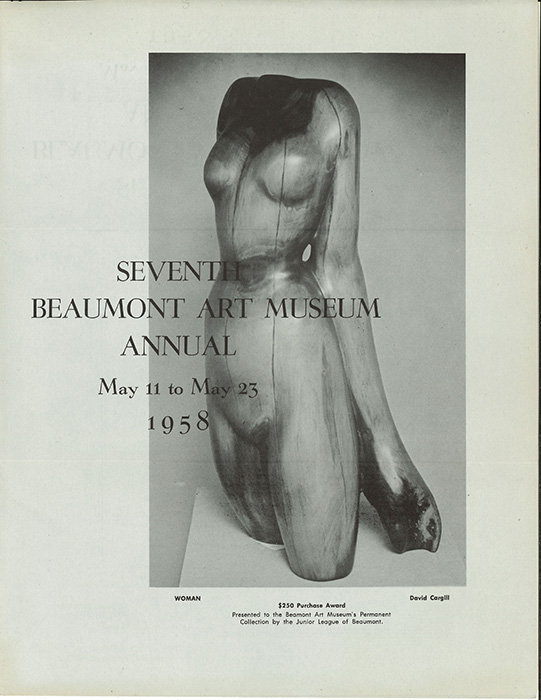
7 ⁄12
Seventh Annual Beaumont Art Museum Exhibition pamphlet, circa 1958 with David Cargill’s “Woman” on cover. Image courtesy of the Art Museum of Southeast Texas.
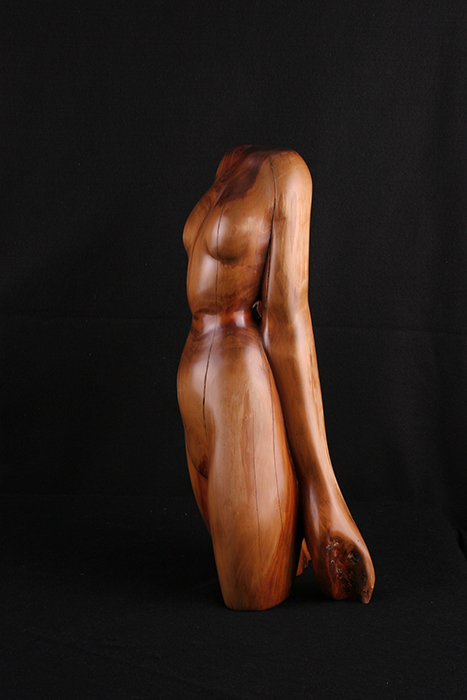
8 ⁄12
David Cargill, Woman, c. 1958, cedar, PC 1958.01, 1958 Junior League Purchase.
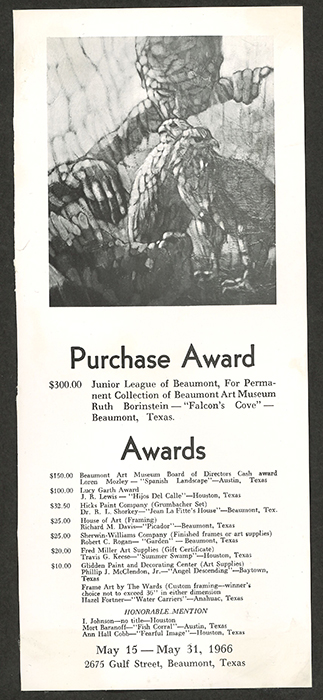
9 ⁄12
1966 Junior League of Beaumont Purchase Award Announcement for Ruth Borinstein’s “Falcon’s Cove”. Image courtesy of the Art Museum of Southeast Texas.
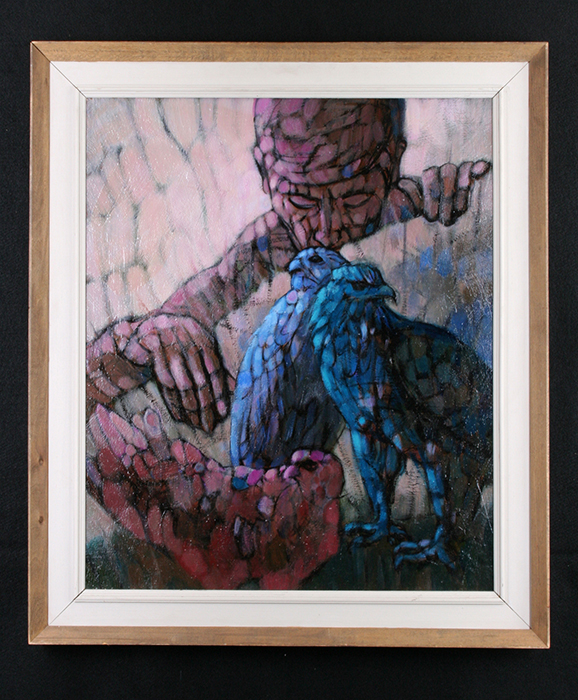
10 ⁄12
Ruth Borinstein, Falcon's Cove, 1965, oil on masonite, PC 1965.03, 14th Annual Purchase Award.
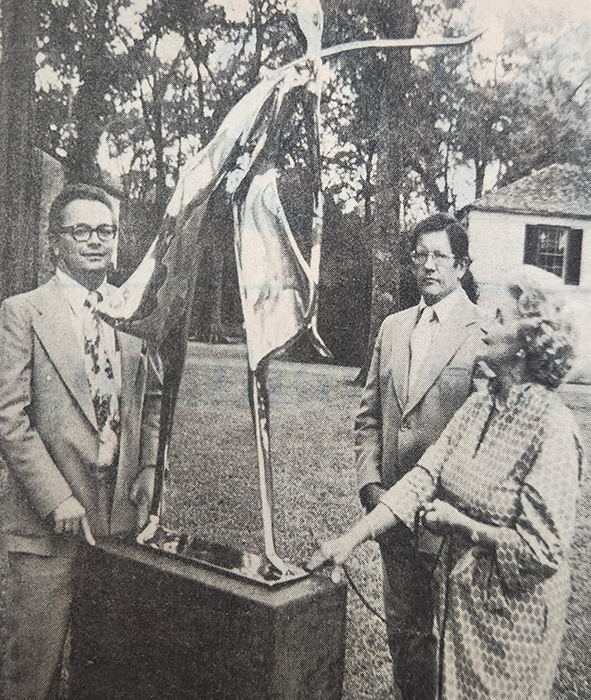
11 ⁄12
Newspaper clipping. Patrick Boyt, left, president of the Beaumont Art Museum board of directors, unveils a new sculpture. David Cargill, the sculptor, is pictured center, and Waifie Hoffman, right, spearheaded the fund-raising drive to purchase the first major acquisition for a new sculpture garden on the museum grounds. C. 1977. Artwork depicted is David Cargill’s “The Importance of Being Mary”. Image courtesy of the Art Museum of Southeast Texas.
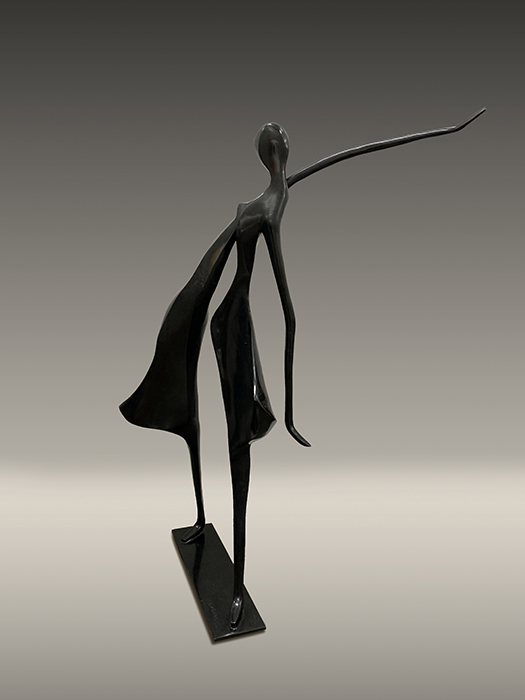
12⁄12
David Cargill, The Importance of Being Mary, 1977, nickel-plated bronze, PC 1977.05, museum purchase.
During those early years, the museum would rotate exhibitions every two weeks, in addition to hosting annual juried exhibitions featuring purchase prizes that would become part of the museum’s permanent collection. AMSET patrons will see one of the prize-winning pieces from the first annual juried exhibition in 1952, a work by Julius Woeltz titled Street Corner, during the show.
From there, The Legacy of Collecting will continue to chronicle AMSET’s history.
The exhibition will showcase everything from the story of its second location, at what was the South Texas State Fairgrounds in 1957, to the donation of a third building from the J. Crooke Wilson estate in 1969 and the eventual split from the still-active Beaumont Art League in 1972.
Throughout, patrons will see works from renowned artists like David Cargill, Richard Stout, Ruth Laird, Kermit Oliver and many others. It all leads up to the museum’s 1987 move to its current location and rebranding as AMSET.
As the museum shifts towards becoming AMSET, Clay highlights the 1986 acquisition of the Felix “Fox” Harris collection as the first major acquisition on the road towards the museum’s current collection of 19th-21st century American and Mexican folk art with an emphasis on works from this region. Harris created captivating totemic structures from scrap metal, debris and other discarded objects found around the area, some towering as high as 15 feet tall. Since 2007, the collection of his works has resided as a semi-permanent exhibition at AMSET.
“There’s a lot of really incredible artworks from contemporary Texas artists that we acquired recently that’ll be phenomenal in that exhibition,” Clay says.
Clay calls out works like ceramics by James Watkins, photographs by Earlie Hudnall Jr. and a painting by Jerry Newman as some of the pieces she’s most excited to see showcased. Newman’s painting, in particular, is of importance to Clay as the artist “taught generations of painters that live here in Southeast Texas.”
In much the same manner, AMSET has been continuing to build its own legacy, thanks to some of the principles on which it was founded. Clay points to AMSET bringing in local artists to teach at summer camps and workshops, while displaying their works in its cafe and subsidiary galleries, as ties to the museum’s original founding goals. The museum also exhibits artists from Lamar University, which Clay notes has taught generations of local artists.
Clay hopes both the anniversary exhibitions illustrate how the museum “has been a cornerstone of the community and has so positively impacted many lives at many different levels.” She adds, “I think it’s just reminding people of the positive impact that AMSET, and before that the Beaumont Art Museum, have had on people’s lives, and that it needs support to continue to do that as well.”
—BRETT GREGA

